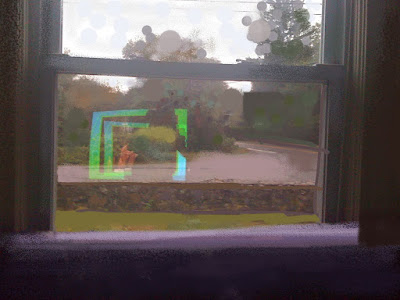
Rainy Day Window, Sketchbook Pro on iPad

Green Tree Seen, 8" x 8" oil on canvas, PRIVATE COLLECTION
On the creative process and new media:
I recently posted paintings about the blank page. Artists of all kinds confront how to get the juices flowing. Transitioning from the activity of regular life to the state of mind of creating can be difficult even though it is craved. It feels great when inspiration self-propels but if the time set aside to work doesn't coincide, it can be hard to break through. I heard a discussion on the subject within an interview of southern writers on NPR. The new book of short stories selected by writer Sonney Brewer called Don't Quit Your Day Job is about the jobs the writers had before writing full-time.
One writer said at the end of his writing session he would leave a line unfinished but only if he knew how to finish it. It would wait for him until next time, a hook to resume the process. Another said he would observe what is around him, however simple, and write a few lines as a warm-up. A visiting artist in undergrad said she put on the same music. I did that a lot in the past but now I do podcasts. My favorite is Fresh Air, Terry Gross' voice settling me into a quiet listening space that allows me to focus. Only problem is I run out of episodes, switching to other podcasts which may be equally interesting but don't have her magic. I scrape down the palette and get out my materials. I look to sketches, out the window, or try to remember what an image seen or imagined. When I worked in an Abstract Expressionist style I could make any mark and have something to respond to. Now the white smooth surface is important to me and I like to be fairly clear on what I'm after from the beginning. Both methods are equally valid. Now the absence of a specific idea feels like muddling around and I don't want the picture to get clogged. You can paint over anything but luminosity is facilitated by light going through paint, bouncing off the white ground and coming back to the eye. Art conservators recommend PVA size for canvas preparation over gesso as it is more resistant to water damage. PVA is clear so the natural color of the canvas, not bright white, is the starting point. Sometimes I like it as it operates as an interactive color much like the colored sheets of paper greatly preferred over white for pastel. I might try an oil based white ground. It is a non-issue for digital images as light comes from the screen. This technicality makes them easier than handling oil which can fight against you. Easier isn't inferior. Additionally, it is easier to think rapidly in a succession of changes and save possibilities with a digital art program. It mirrors quantum physics, showing outcomes of a multiplicity of actions (thanks to Chuck and Josh from How Stuff Works, Stuff You Should Know for explaining the science). It can be done in old-fashioned drawing but the stages can be lost unless one uses photography to document them. The exhibit of Matisse on view at the MOMA (Radical Invention, 1913-1917) uses technology to unravel the series of actions he took in making singular works. Now we can playback actions using Brushes' ability to transfer them into a Quicktime video or, as aforementioned, by saving intermediate steps as separate files, some as complete works on their own. The problem of when a picture is done in contemporary painting is stretched, made pluralistic.
Sonny Brewer quoted Truman Capote:
"Truman Capote just said, 'Write something true,'" Brewer says. "It doesn’t matter if it fits in the book or not, but if it’s true that the wind is blowing and that the sky is blue … write the truth for a minute."
"Then, start lying," Groom adds. "A very convincing lie." [Copyright 2010 National Public Radio].
Green Tree Seen was made in this way. I always look around when I'm outside for striking visual situations and I saw a tree which became my own in the studio. Looking from dot to dot is a journey in its greenery. Texture is an important part of the looking experience here as is in Rainy Day Window, something like oil pastel. I took the photo of the window, surprised by the reflection of synthetic colored light from the T.V. I imported the photo into Sketchbook Pro on the iPad and reworked it. So I adapt and utilize the new tools available to painters to bang through to the idea. Much more will come.

No comments:
Post a Comment